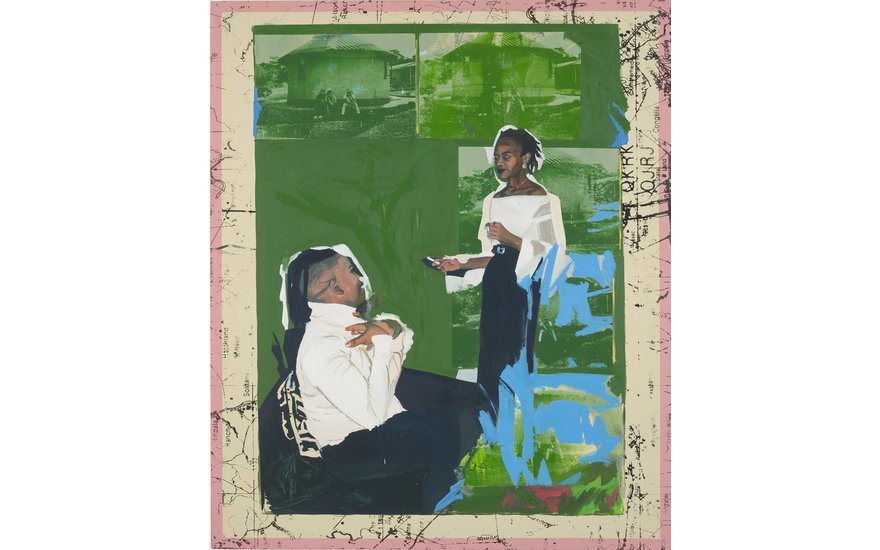Victoria McCraven, MA History of Art
I guess being a black body there is a sense that politics will follow you wherever you go. There’s nothing you can do about that. But how can I escape that just for a little while and carve my own ideas about the world, carve my own identity.
Image Caption: Hwami’s oil painting Newtown explores the past, present and future with slick elegance (Credit: Work by Zudzanai-Violet Hwami, photographed by Andy Keate)
If you haven’t seen it yet, make sure you pay a visit to see Kudzanai-Violet Hwami’s incredible solo show, (15,952km) via Trans-Sahara Hwy N1, at Gasworks in Vauxhall. The exhibition which is on display until 15 December 2019, marks the artist’s first solo exhibition as studio holder at Gasworks which was supported generously by the Tyburn Gallery. Gasworks is a non-profit arts collective in South London which has been providing studio space for emerging artists for over twenty-five years. Hwami’s exhibition is free and open to the public Wednesday-Sunday, 12-6 pm.
The exhibition has a total of ten works which are displayed across two galleries. In her process, Hwami begins by working with collage to incorporate her family portraits and some of her photography, then renders the works in oil paint. Hwami was born in Zimbabwe but left due to political unrest and grew up in South Africa. The exhibition’s title accounts for the journey from her home town in Zimbabwe to Capetown through to London. This body of work was created during her month-long stay at an artist’s collective in Dzimbanhete, Zimbabwe, where she lived with a healer.
In an interview for Gasworks Hwami said:
‘Because I’m black, because I am Shona, and because I am lesbian and all of this stuff, I guess I have to find a way to bring those in the works. Not necessarily, because I think sometimes it hinders the work, but those themes find themselves in the paintings. I guess this also goes with avoiding political themes, although I guess being a black body there is a sense that politics will follow you wherever you go. There’s nothing you can do about that. But how can I escape that just for a little while and carve my own ideas about the world, carve my own identity.’
In her work Newtown, Hwami urges the viewer to think simultaneously of place and place-naming through her use of a map, framed within a pink border. Two female figures are presented centrally, one standing holding a cigarette while the other is seated. If you look closely, there is a photograph layered in the background of two men in front of a home. As the photograph is replicated, it becomes more distorted and disappears behind the two women. As viewers, we are unsure of the relationship between the women. However, Hwami captures the joy they share and leaves us to create our own conclusion. In the final work of the exhibition, Speaking in Tongues, Hwami shows a clustering of small canvases to create a larger work on the back wall. The small works portray people, cows, chickens, plants, and deities in inverted colours which draws possible connections to ritualistic practice. In her interview, Hwami expands on her use of small works as a way of inviting the viewer in. For her, the small works connect to the digital age and social media platforms, the same way Tumblr and Instagram contribute to the dissemination of images and the normalized action of swiping through content in search of the next image.
Overall, it is an excellent show that uniquely encapsulates the themes of family, nature, and consumerism and is definitely worth the trip to Vauxhaull.
